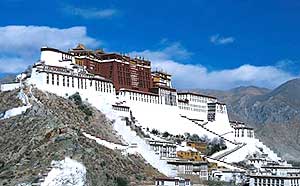The Potala Palace -- a treasure house in Lhasa
China View, Dec 6, 2004
Lhasa, Tibet (China) -- Little remains of the original Potala Palace of the seventh century, built as a place for meditation by King Songtsen Gampo on the occasion of his marriage to Princess Wencheng of the Tang Court. Standing atop the Red Hill in Lhasa, the current structure dates from the 17th century; it was rebuilt by the 5th Dalai Lama and became the Winter Palace of the Dalai Lamas from that time. The 13-story building of 1,000 rooms can be seen from many miles away.
 The Potala is divided into two sections--an outer section, the White Palace, and an inner section, the Red Palace, the latter containing the temples and reliquary tombs of the Dalai Lamas. The entire building is a structure of stone and timber. At a height of 117 meters, the Potala was the world's tallest building until 20th-century architects designed cityscapes of new buildings that far surpassed the Potala in height--but not in its architectural majesty.
The Potala is divided into two sections--an outer section, the White Palace, and an inner section, the Red Palace, the latter containing the temples and reliquary tombs of the Dalai Lamas. The entire building is a structure of stone and timber. At a height of 117 meters, the Potala was the world's tallest building until 20th-century architects designed cityscapes of new buildings that far surpassed the Potala in height--but not in its architectural majesty.
There are small palaces within grand palaces. The Potala stands so high that it looks like a magnificent castle in the heavens. The statues of King Songtsen Gampo and Princess Wencheng are the worship. Among the eight tomb pagodas of the Dalai Lamas, the tomb of the fifth Dalai Lama is the most extravagant,14 meters high. Eleven thousand ounces of gold were used in the gold plating, the designs and decorations all inlaid with diamonds and pearls as well as turquoise, agate, and coral stones.
The Potala is a treasure house, since it contains the golden handwritten Buddhist scriptures, valuable gifts from Chinese emperors, and a lot of priceless antiques. There are many colorful sculptures and paintings chronicling Buddhist folklore and ancient Tibetan life. The Potala Palace deserves the title of art gallery and museum; it is also a symbol of the wisdom and power of the Tibetan people.

 The Potala is divided into two sections--an outer section, the White Palace, and an inner section, the Red Palace, the latter containing the temples and reliquary tombs of the Dalai Lamas. The entire building is a structure of stone and timber. At a height of 117 meters, the Potala was the world's tallest building until 20th-century architects designed cityscapes of new buildings that far surpassed the Potala in height--but not in its architectural majesty.
The Potala is divided into two sections--an outer section, the White Palace, and an inner section, the Red Palace, the latter containing the temples and reliquary tombs of the Dalai Lamas. The entire building is a structure of stone and timber. At a height of 117 meters, the Potala was the world's tallest building until 20th-century architects designed cityscapes of new buildings that far surpassed the Potala in height--but not in its architectural majesty. 